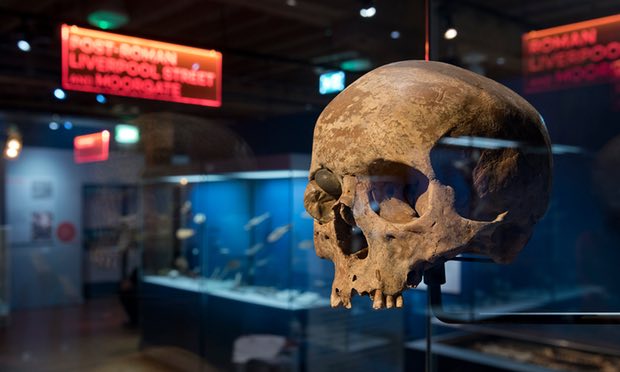“We have a view of the Victorians as being po-faced and strait-laced, and it’s quite funny to think of someone having that under their beds,” says Jackie Keily, a curator at the Museum of London. She’s talking about a Victorian chamber pot comically depicting a man with his hair standing on end, with text that reads: “Oh what I see I will not tell.”
Found at Stepney Green, the chamber pot is one of Keily’s favourites of the tens of thousands of objects dug up in 40 archaeological excavations carried out as part of the eight-year Crossrail project to build a new rail line across London. Another favourite, says Keily, who is curating an exhibition of 500 Crossrail artefacts at the Museum of London Docklands, is a Roman medallion found near Liverpool Street station, presented in AD245 by the Emperor Philip to a high-ranking official. “It’s only the second example that’s ever been found, and the other example was found in the 19th century in Rome. You wonder how it got there, who brought it with them and then how did they lose it – were they heartbroken?”
Known as the Elizabeth line, the new route, which begins at Reading, west of London, and ends at Shenfield to the east, has provided archaeologists with rich pickings. The findings, spanning 8,000 years of human history, are dizzying in their diversity: remains of flint tools from a Mesolithic toolmaking site in north Woolwich, ice skates made of animal bone in the medieval period and 13,000 pickle pots and jam jars dating from the 19th and early 20th century, from the Crosse & Blackwell factory at Tottenham Court Road.
Other finds are prehistoric, including the 68,000-year old remains of bison and reindeer found at Royal Oak. “The beauty of the Crossrail project is that it’s got so many different stories of different periods of time, and so many different types of artefact that we can thread them all in together,” says Keily. Those thousands of artefacts will eventually be stored at the Museum of London’s vast archaeological archive in north London.
But the popular notion that Crossrail workers simply turned up valuable objects as they went about their labours is entirely fanciful. Archaeologists were closely involved in planning the excavations, which ran concurrently with the engineering work: in most cases, says historian Gillian Tindall, author of The Tunnel Through Time, they knew what they were looking for: “The idea that the Crossrail engineers tunnelled along saying, ‘Oh look, we found some bodies here’ – this is bollocks.” The tunnels themselves were too deep, she adds, to produce any archaeological information; instead, the digs were sited at the ticket halls and ventilation shafts.
Although there were few surprises, the excavations have filled in pieces of an existing jigsaw, says Mike Henderson, a senior osteologist at Museum of London Archaeology (Mola), which took part in the digs. One of the most exciting was at Liverpool Street, where archaeologists dug through multiple historical layers to expose vivid evidence of the Roman occupation – including wheel ruts running across the site and Roman horseshoes known as hippo sandals. “This reflects the volume of traffic coming in and out of the city,” says Henderson.
The same site turned up 20 skulls in a roadside ditch dating from the second century AD, which Dominic Perring, director of the centre for applied archaeology at University College London, believes may have been removed from corpses by Roman soldiers and thrown away as a deliberate act of disrespect to the dead. Combined with existing evidence, including fire damage to London and a military Roman fort, the skulls suggest those soldiers may have been there to quell a revolt: “These three strands of evidence fit within a period when we know that Britain had seen major unrest.”
Perhaps the most revealing finds – as well as the most gruesome – have been the burial pits. New scientific developments, including DNA analysis, mean that archaeologists can learn a good deal of information from skeletons. Analysis of those found at Liverpool Street, dating from the 17th century Bedlam burial ground, have identified the presence of Yersinia pestis – the plague bacterium. But they bring to light other secrets too, including evidence of two new habits, says Henderson: “Sugar comes into the diet at this time. It becomes more and more affordable, so we saw an increase in dental disease. And we saw rounded wear marks in people’s teeth where they’ve been smoking pipes.”
At Charterhouse, near Smithfield, skeletons dating from the 14th century were found to have died of the Black Death – the same plague that swept London three centuries later. But the findings turn some of our preconceptions on their head, says Tindall: “What they found was, not bodies tumbled together as they’d expected, but rather orderly burials with people laid in rows with their bodies orientated in one direction.” Taken together with analysis that shows not all of them died of the plague, it is evidence, Tindall argues, that previous estimates of the numbers who died in the Black Death epidemic were exaggerated.
The findings of the Crossrail excavations will keep archaeologists busy for some time, but for Keily the joy has been in seeing the unfolding of a unique story spanning thousands of years: “It’s gone right across the centre of London and then sliced down through it in time.”
This article first appeared in the Guardian’s public leaders network.

